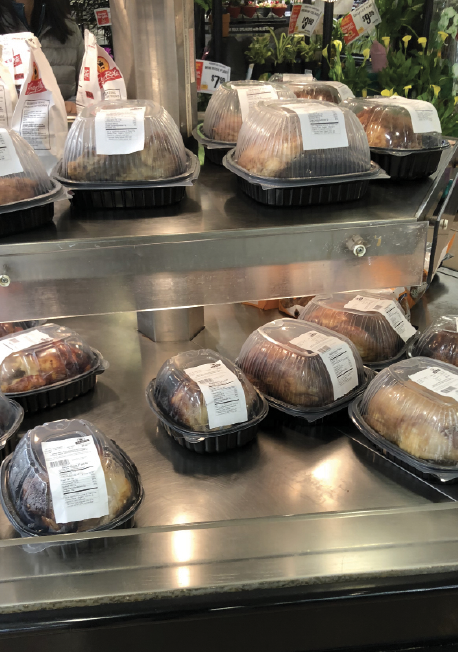Chickenomics: The untold truth of rotisserie chickens
Photo Jared Greenspan
Rotisserie chickens from ShopRite
Walking through a grocery store, the savory aroma of rotisserie chicken envelops the air, drawing numerous customers to the attraction. They reach for the finest chickens, which stock the heated shelves, as they scout out that night’s dinner. Nothing is abnormal about the flock of shoppers surrounding the area, but the price tag reveals a peculiar twist to the industry’s narrative: the hearty chickens, enough for three dinners in some cases, costs a meager $4.99.
All businesses strive for the same goal: to make a profit. To increase yearly revenue and avoid closure, businesses must appropriately set prices to garner a sufficient profit without turning away possible customers.
According to the National Chicken Council, as of 2016, the standard retail price for chickens was $1.42 per pound. For a 3.5 pound rotisserie bird, the total price should be $4.97, on par with the $4.99 price that Costco and other grocery chains commonly use. On the surface, the inexpensive price seems contradictory to a business’s goal of making a profit.
In a 2015 report by the Seattle Times, Richard Galanti, Costco’s chief financial officer, admitted that the grocery chain had lost money by retailing their rotisserie chickens at such a low figure. “We were willing to eat, if you will, $30 to $40 million a year in gross margin by keeping it at $4.99,” Galanti said.
Costco willingly loses money on rotisserie chickens to stimulate the sales of other items; these additional items are priced at or above retail level, leaving the opportunity for profit ajar. Since rotisserie chickens are often purchased as the foundation of a dinner, customers are more inclined to purchase additional items in the deli aisle to complement the meal. This strategy is known in the marketing industry as a loss leader.
Costco is not alone in their usage of the loss leader tactic. At the Westfield Stop and Shop, an anonymous employee broke down the strategy: “You get [the customers] to come in, and hopefully they buy something else,” he said. “It’s like a come-on, like when you see a car real cheap in the newspaper but have to pay for all the unincluded finishing and details.”
John Stanton, a food marketing professor at St. Joseph’s University, acknowledged that a loss leader “is a way to get consumers into the store so they most often buy more than the chicken.” According to Stanton, stores will commonly deploy loss leaders to sell one thing at or below face value and make up the lost money on corresponding products purchased.
While many grocery stores justify their low pricing on rotisserie chicken with the loss leader technique, others opt to lowball customers with an equally deceptive tactic. Stores tend to use significantly smaller, underweight chickens, turning a steal into a waste of money.
“Those [uncooked] chickens are twice the size as the rotisserie,” an anonymous Stop N Shop employee said. “The rotisserie out there are around two pounds, but those are at like four, five, six, seven pounds.”
At Shoprite, Stop & Shop, and Costco, all of the rotisserie chickens on display weighed between 30 and 48 ounces. In comparison, at the same stores, the uncooked chickens weighed between 80 and 86 ounces, proving to be significantly larger birds than the rotisserie.
“When smaller chickens come in, stores will often have trouble selling them,” Stanton explained. “But when they are turned into rotisserie chickens, there’s no problem. It’s an easy way to get rid of smaller birds.”
Tom Heinen, the owner of Heinen’s Grocery Stores, an Ohio-based chain, admitted to the Hi’s Eye that “some companies play games with their customers” by using smaller chickens. When stores receive lightweight chickens, they will use the rotisserie outlet to dispose of an otherwise unmarketable product.
While the chickens do lose weight during the roasting process, this figure is not substantial enough to account for the weight differences between rotisserie and uncooked chickens. Statistics from the USDA from their “Cooking Yields for Meat and Poultry” study indicate that, on average, chickens lose 20 percent of their overall weight when roasted; such a percentage solidifies the small bird theory in that the rotisserie chickens, even before being roasted, are still smaller.
Whether it be through small birds or loss leaders, the story of the rotisserie chicken is that of clever marketing tactics disguised in finely roasted and seasoned poultry available to the convenience of customers. It is grocery store economics at play, pleasing both the likes of chicken hungry customers and, while deceptively, the pockets of grocers across the nation.

